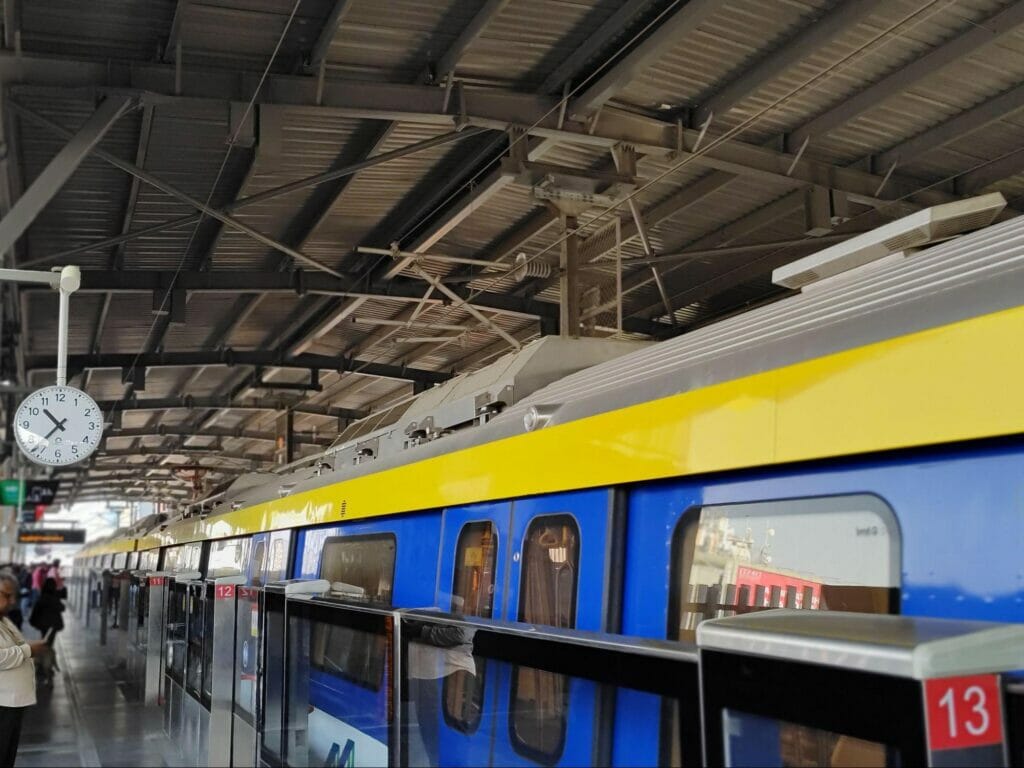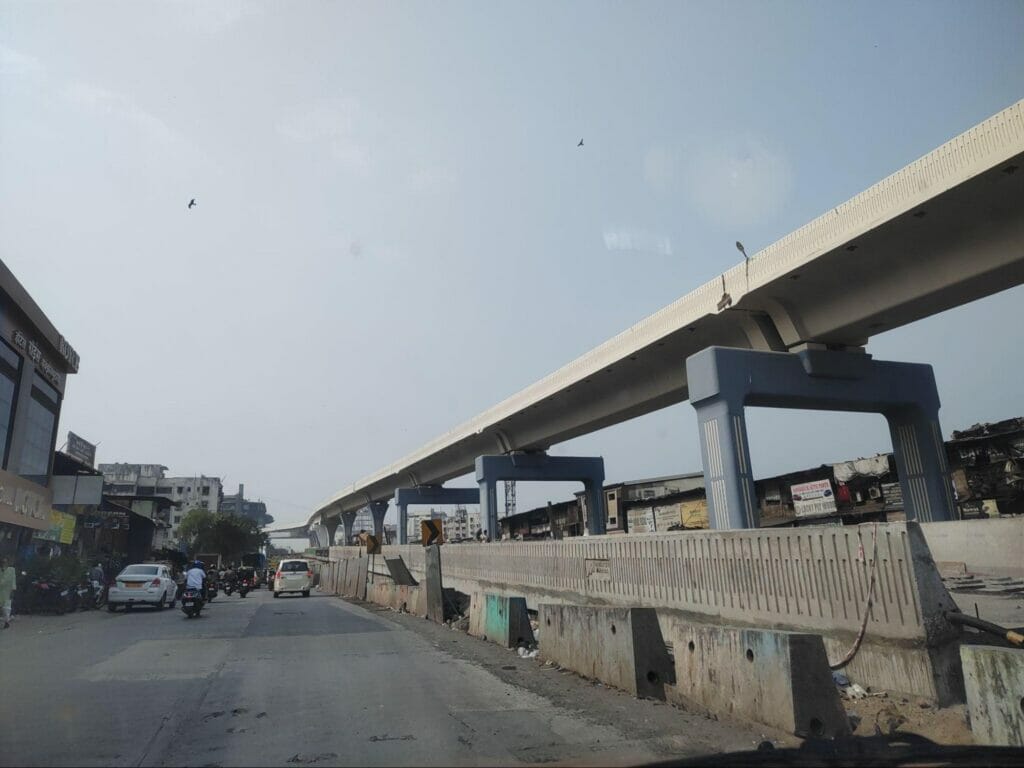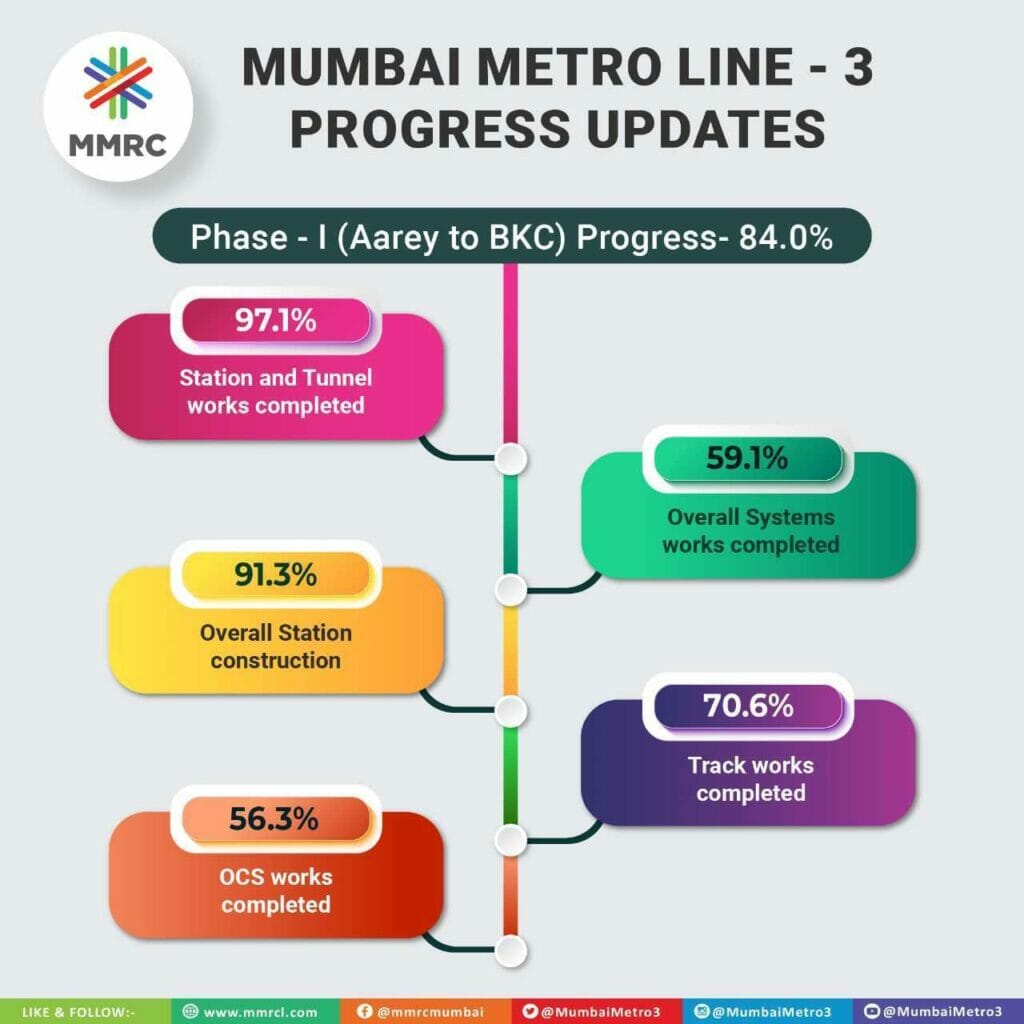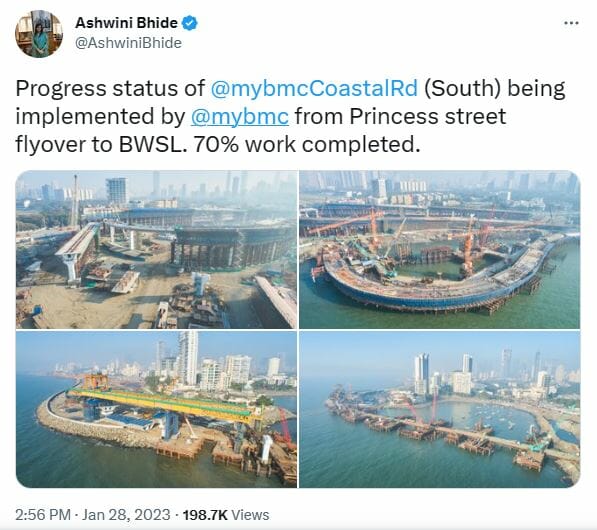2023 has arrived and with it, hopeful Mumbaikars are looking forward to some of the key infrastructure projects opening to the public this year. Surrounded by barricades in all parts of the city for the past five years, at least a few of these barricades will be pulled down and new modes and alternatives of transport and commuting will be thrown open to the public.
These promise to change the face of Mumbai, and most likely, they will! The Trans-Harbour Link, metro lines 2A & 7, the underground metro line 3, the Santacruz-Chembur Link Road extension, and the coastal road are the top transformative projects up for opening this year. Let’s have a look at each of them, and what they bring to the table for Mumbai and Mumbaikars.
Metro lines 2A and 7
With the entire stretch of the metro lines 2A and 7 having begun operations in January 2023, a transformation of the way people live and work in the western suburbs is afoot.
The much-needed north-south connector in the crowded western suburb, Line 2B, starts from Dahisar East and moves towards the West, continuing till Andheri West at DN Nagar station on Line 1. Line 7 begins with Line 2A, moving parallel to the WEH and ending at Andheri East. With these two lines running, it is estimated that the crowd on the Western Railways (WR) and the traffic on Western Express Highway (WEH) will decrease to an extent.

Another important milestone Mumbai has achieved with the two lines is of a metro “network”, not just standalone lines. For the first time, interchanging between metro lines is possible. This integration means anyone from the Western suburbs can travel to Ghatkopar and vice versa by hopping on and off the metro, without exiting the stations.
Santacruz-Chembur Link Road Extension
Ever since the Santacruz-Chembur Link Road (SCLR) was thrown open in 2014, it has quickly become the city’s most important east-west connector, leaving behind the Jogeshwari-Vikhroli Link Road (JVLR). As a result, the link became congested at the BKC junction and required an immediate solution.
In 2016, the Mumbai Metropolitan Region Development Authority (MMRDA) began work on expanding the SCLR from BKC junction to the WEH at Santacruz. The SCLR extension work is now nearly finished and should be inaugurated partially – between Kalina, the Bandra Kurla Complex (BKC) and the Kurla bus depot – in February 2023. The remaining Phase 2 will start on June 2023. Vehicles will be able to zip past the BKC junction, Kalina and Vakola signals to reach the WEH directly.

Chheda Nagar Junction Improvement
A consequence of the SCLR has been the traffic congestion of the Eastern Express Highway (EEH) at the Chheda Nagar junction. To improve this, a bridge from the Eastern freeway to EEH towards Thane has been planned for 2023, which will allow vehicles to skip the busy junction on their way towards Thane.
Another improvement is the construction of a new flyover on the EEH. The current one skips only one out of two junctions on towards Thane, but the new flyover will change that.
As of January 24th, all steel girders over the EEH flyover have been placed. Only the deck and other preparatory works remain. The MMRDA is preparing to open the flyover in February 2023.
Vasai Creek Bridge
The Vasai Creek Bridge on NH8 – the only link between Vasai-Virar and Mumbai – is all set to complete in 2023. Under this project, a new bridge will be built over Vasai creek. There will also be an interchange at the Fountain Hotel signal, so vehicles can cross the junction without waiting at the signal.
The spans of the creek bridge are almost complete and, according to the National Highways Authority of India (NHAI), should be open to traffic in the first quarter of 2023.
Dombivli-Thane Link Road
For residents of Dombivli, who have to take a detour to Kalyan to reach the Mumbai-Nashik highway, the Dombivli-Thane link road will be a massive boon. Work on the bridge, linking Mankoli in Dombivli and Mothagaon in Bhiwandi, is 80% complete, and the MMRDA has given a tentative opening date of April 2023.
Read more: Mumbai metro update: Now a two-year wait for the next line
Mumbai Metro Line 3 (SEEPZ-BKC)
The most challenging metro Line 3 may partially begin operations in December 2023. Two trainsets have already reached the city and trial runs are underway. The station progress is impressive as well, and work on restoring roads above stations has also started. The Line 3, once fully open, will connect multiple points of interest like SEEPZ-MIDC, both Airport terminals, BKC, Dadar, Siddhivinayak, Worli, CSMT, Churchgate and Cuffe Parade. It is a north-south line that runs through the centre of Mumbai.
Phase 1, which is the most that will open to the public this year, runs between SEEPZ and BKC. Through its connection to Line 1, it will offer a new public transport route for people coming from different parts of the city to the business districts of BKC and Andheri East.
Phase 2 will complete the connection from Aarey to Cuffe Parade and throw open a whole new world of possibilities. But that will happen in 2025.

Mumbai Trans-Harbour Link Project (MTHL)
Perhaps the most ambitious project out of the lot, the MTHL is an important attempt at bringing the island city closer to the mainland. It will provide an alternative route between Navi Mumbai and South Mumbai. There are high hopes for the bridge, as it is expected to reduce traffic on the Vashi bridge and Sion-Panvel Expressway; serve as the most important link to the upcoming Navi Mumbai International Airport; and, act as a shortcut for people travelling towards Pune from South Mumbai, thus decongesting Navi Mumbai.
Apart from adding key connections to the city, the MTHL also opens up new possibilities for development from the south of Navi Mumbai up to Panvel. It currently stands at 90% complete. The MMRDA is aiming to open it by November this year.
Coastal Road
The Coastal Road is perhaps the most ambitious project undertaken by the Brihanmumbai Municipal Corporation (BMC) till date. It adds a much-needed four-by-four lane highway to South Mumbai, along with many open spaces along the route on reclaimed land.
South Mumbai does not have a single express highway with more than three lanes. The suburbs have the WEH & EEH for faster traffic movement. The completion of the coastal road will give Mumbai a north-south highway that runs from Dahisar to the Bandra-Worli Sea Link (BWSL) to Marine Drive. This is a much-needed augmentation for the city, which is why the project is often called transformative. The addition of open spaces only makes it better.

As per the latest update, 70% of progress on the portion being constructed by the BMC – from the Princess Street flyover to the BWSL – is complete. It is likely to be partially commissioned by December 2023.
With these projects set for opening in 2023, Mumbaikars will experience a transformation in their commute.
It is ridiculous that Sunit Raut is calling the coastal road project, which is a disastrous project that will worsen traffic, a much-needed augmentation for the city. It has also destroyed coastal ecosystems and blocked humans’ natural access to the sea. Highways and especially urban highways are harmful and unnecessary. Road expansion for the use of private vehicles does not reduce traffic, and so any hopes of faster travel due to adding of lanes or flyovers will be short-lived. It should also be mentioned that metros are very harmful for the environment and are partly responsible for Mumbai’s horrible air quality. Improving ground public transport like buses is the only main way to improve transport as well as the environment and reduce traffic jams.
You are absolutely right sir this road expansion is done for the private vehicles only. Mumbai pollution will increase ,more population will attract towards Mumbai, it will get densely populated…
Let me address your concerns:
1. Coastal Road does not block our natural access to sea. The Coastal road will have promenade along it’s entire length facing the sea just like the old Worli Seaface.
2. Coastal road is not an extra highway or road. It is an important link as there is no proper highway to serve South Mumbai till date. It is a basic need. Coastal road is not a mere road expansion project as per common myth.
3. Metros are environment friendly and do not emit pollutants in it’s immediate surroundings as all trains run on electricity. So it is incorrect to say metro is the reason for Mumbai’s poor AQI.
4. Bus systems are a part of last mile connectivity option and not the only solution to public commute issues. Buses play a specific role and cannot replace metros or cars completely. Plus current fleet of buses mostly runs on fuel.